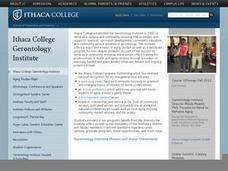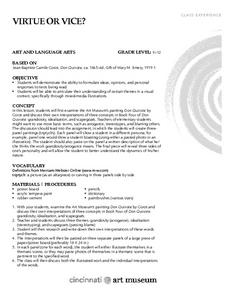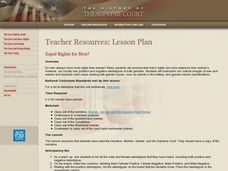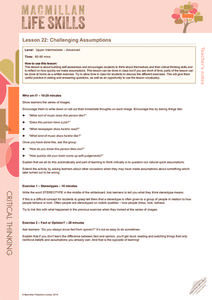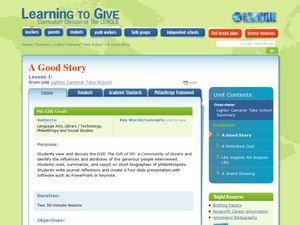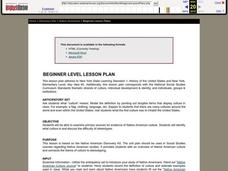Curated OER
Shakespeare 2000
Young thespians can try their hand at writing a script and acting out a scene, while gaining a deeper understanding of the universal topics presented in Shakespeare's wide array of plays. Begin the lesson by conducting a compare and...
Curated OER
Emotional Needs
Learners analyze the physical characteristics of old age. They identify and differentiate diseases of old age. They analyze the stereotypes of older adults and write summaries of responses by other groups.
Curated OER
Virtue Or Vice?
Young scholars create triptychs, pictures in three panels side by side, of certain themes displayed in the painting "Don Quixote" by Jean-Baptiste Camile Carot. Student evaluations are accomplished through participation during in-class...
Curated OER
The Five Senses
Students participate in a scavenger hunt using their sense of sight. They bring various texture materials from home and discuss how things feel. Students identify the smells inside five jars. They discuss things they hear and why hearing...
Curated OER
Sampling Rocks
Students collect and sort rocks based on visible characteristics. In this statistics lesson, students determine adequate sample size and categorize rocks based on characteristics. The book Everybody Needs a Rock is read to...
Curated OER
Equal Rights for Men?
Study the issue of gender bias in court cases with a resource that ponders the extent of gender equality. Learners examine cultural images of men and women and examine court cases dealing issues such as women in the military.
Macmillan Education
Challenging Assumptions
After experiencing how quick and easy it is to make judgments as part of an opening activity, learners discuss the concept of a stereotype and the need to think critically and question our immediate assumptions.
Museum of Tolerance
Developing Media Literacy
To protect young people from questionable content, many schools limit access. This resource suggests that because learners can so readily avail themselves to unrestricted Internet access, it is vital for 21st century...
Curated OER
Talk Back
Students study print and TV ads and search for examples in which advertising companies rely on negative stereotypes or misleading information to market their products.
Curated OER
"What Do You Mean?" How Language Changes Over Time
Young scholars examine words used at Jamestown in 1607. They predict what the words meant in 1607, write sentences using three of them, then analyze the sentences after they have read the actual definitions of the words.
Curated OER
Connecting Math to Our Lives
Students participate in an online interactive forum to explore how math is used in their families and communities. They design games to submit to other students online, and identify and organize data to solve the problems from other...
Curated OER
Center Stage—Focus on Poverty
Students explore the concept of philanthropy. In this service learning lesson, students examine stereotypes and discrimination based on socio-economic status. Students prepare to work with people of diverse backgrounds in service...
Curated OER
Setting the Stage for Service Related Learning Relationships
Students understand the stereotypes and realities of older people. In this philanthropic lesson, students in groups read and report on the positive images of older people in children's books. Students address the needs and wants of older...
Curated OER
Poet Naomi Shihab Nye
Students read and analyze poetry by Naomi Shihab Nye. They define stereotypes, view and discuss a video interview with Nye, present an oral reading of a poem, and write a persuasive letter to an author.
Curated OER
Native American History
Young scholars examine how Chief Joseph attempted to challenge stereotypes about Native Americans. In this Native American history lesson, students read "An Indian's Views of Indian Affairs," and then paraphrase the selection. Young...
Curated OER
Preparing the Soil
Students explore the concept of philanthropy. In this service learning lesson, students read Seedfolks and discuss the characters in the story and consider their actions that led to a community garden. Students journal about their...
Curated OER
A Good Story
Students explore the contributions of philanthropists. In this philanthropy instructional activity, students watch "The Gift of All: A Community of Givers." Students then read biographies of philanthropists and create PowerPoint...
Curated OER
The Native American Indian Women Quest
Students research background information on the role of Native American women. They then participate in a four station center which enables the students to view pictures, investigate new vocabulary, and research Native American recipies.
Curated OER
LET'S PARTY!
Students identify a number pattern and extend the number sequence. They make generalizations given a specific pattern and create, describe, and extend patterns. They create a table that describes a function rule for a single operation...
Curated OER
Rescue at Sea
Students examine stereotypes that they may have regarding scientists. They read and discuss 'Scientist at Work: High Seas Hunter Pleads for Preservation of Fish' and reflect on the work of a Marine Conservationist.
Curated OER
The Sky is Falling!!
First graders complete a variety of activities about fall. They study a plant's life cycle and what happens to plants in the fall. They make leaf rubbings and discuss seed dispersal. They write a creative story about a seed and visit a...
Curated OER
Grade 3: Palindrome Patterns
Third graders use addition to create numbers that are palindromes and organize their results to look for patterns. They make generalizations from patterns and practice reading large numbers and addition with regrouping.
Curated OER
Modeling Reality
Students identify what a role model is and what characteristics such a person should possess. They discuss a new trend in character role model figurines, which some believe perpetuate racial and ethnic stereotypes.
Curated OER
Native Americans
Students are be able to examine primary sources for evidence of Native American culture. They identify what culture is and discuss the difficulty of stereotypes. Students are given examples of different cultures.

